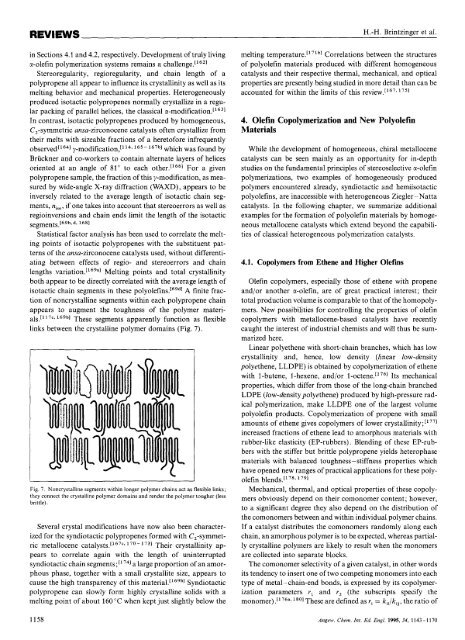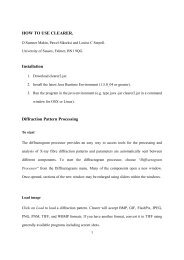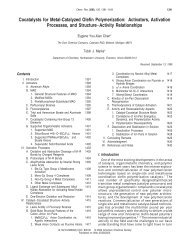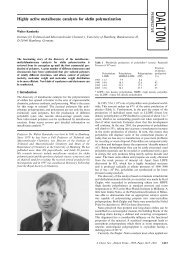Stereospecific Olefin Polymerization with Chiral Metallocene Catalysts
Stereospecific Olefin Polymerization with Chiral Metallocene Catalysts
Stereospecific Olefin Polymerization with Chiral Metallocene Catalysts
Create successful ePaper yourself
Turn your PDF publications into a flip-book with our unique Google optimized e-Paper software.
REVIEWS<br />
in Sections 4.1 and 4.2, respectively. Development of truly living<br />
a-olefin polymerization systems remains a challenge.['621<br />
Stereoregularity, regioregularity, and chain length of a<br />
polypropene all appear to influence its crystallinity as well as its<br />
melting behavior and mechanical properties. Heterogeneously<br />
produced isotactic polypropenes normally crystallize in a regu-<br />
lar packing of parallel helices, the classical a-m~dification.['~~~<br />
In contrast, isotactic polypropenes produced by homogeneous,<br />
C,-symmetric ansa-zirconocene catalysts often crystallize from<br />
their melts <strong>with</strong> sizeable fractions of a heretofore infrequently<br />
observed['641 y-modification,["4. 165- 167b1 which was found by<br />
Bruckner and co-workers to contain alternate layers of helices<br />
oriented at an angle of 81" to each other.['661 For a given<br />
polypropene sample, the fraction of this y-modification, as measured<br />
by wide-angle X-ray diffraction (WAXD), appears to be<br />
inversely related to the average length of isotactic chain segments,<br />
nisor if one takes into account that stereoerrors as well as<br />
regioinversions and chain ends limit the length of the isotactic<br />
segments.[69b. d, 1681<br />
Statistical factor analysis has been used to correlate the melting<br />
points of isotactic polypropenes <strong>with</strong> the substituent patterns<br />
of the ansa-zirconocene catalysts used, <strong>with</strong>out differentiating<br />
between effects of regio- and stereoerrors and chain<br />
lengths Melting points and total crystallinity<br />
both appear to be directly correlated <strong>with</strong> the average length of<br />
isotactic chain segments in these poly~lefins.[~~~l A finite fraction<br />
of noncrystalline segments <strong>with</strong>in each polypropene chain<br />
appears to augment the toughness of the polymer material~.["~~'<br />
169b1 These segments apparently function as flexible<br />
links between the crystalline polymer domains (Fig. 7).<br />
Fig. 7. Noncrystalline segments <strong>with</strong>in longer polymer chains act as flexible links;<br />
they connect the crystalline polymer domains and render the polymer tougher (less<br />
brittle).<br />
Several crystal modifications have now also been characterized<br />
for the syndiotactic polypropenes formed <strong>with</strong> C,-symmetric<br />
metallocene catalysts.[167c* 170-1731 Their crystallinity appears<br />
to correlate again <strong>with</strong> the length of uninterrupted<br />
syndiotactic chain a large proportion of an amorphous<br />
phase, together <strong>with</strong> a small crystallite size, appears to<br />
cause the high transparency of this material.['69b1 Syndiotactic<br />
polypropene can slowly form highly crystalline solids <strong>with</strong> a<br />
melting point of about 160 "C when kept just slightly below the<br />
I<br />
H.-H. Brintzinger et al.<br />
melting Correlations between the structures<br />
of polyolefin materials produced <strong>with</strong> different homogeneous<br />
catalysts and their respective thermal, mechanical, and optical<br />
properties are presently being studied in more detail than can be<br />
accounted for <strong>with</strong>in the limits of this review.['67, 1751<br />
4. <strong>Olefin</strong> Copolymerization and New Polyolefin<br />
Materials<br />
While the development of homogeneous, chiral metallocene<br />
catalysts can be seen mainly as an opportunity for in-depth<br />
studies on the fundamental principles of stereoselective a-olefin<br />
polymerizations, two examples of homogeneously produced<br />
polymers encountered already, syndiotactic and hemiisotactic<br />
polyolefins, are inaccessible <strong>with</strong> heterogeneous Ziegler- Natta<br />
catalysts. In the following chapter, we summarize additional<br />
examples for the formation of polyolefin materials by homoge-<br />
neous metallocene catalysts which extend beyond the capabili-<br />
ties of classical heterogeneous polymerization catalysts.<br />
4.1. Copolymers from Ethene and Higher <strong>Olefin</strong>s<br />
<strong>Olefin</strong> copolymers, especially those of ethene <strong>with</strong> propene<br />
and/or another cc-olefin, are of great practical interest; their<br />
total production volume is comparable to that of the homopolymers.<br />
New possibilities for controlling the properties of olefin<br />
copolymers <strong>with</strong> metallocene-based catalysts have recently<br />
caught the interest of industrial chemists and will thus be summarized<br />
here.<br />
Linear polyethene <strong>with</strong> short-chain branches, which has low<br />
crystallinity and, hence, low density (linear low-density<br />
polyethene, LLDPE) is obtained by copolymerization of ethene<br />
<strong>with</strong> I-butene, I-hexene, and/or l-~ctene.~'~~] Its mechanical<br />
properties, which differ from those of the long-chain branched<br />
LDPE (low-density polyethene) produced by high-pressure rad-<br />
ical polymerization, make LLDPE one of the largest volume<br />
polyolefin products. Copolymerization of propene <strong>with</strong> small<br />
amounts of ethene gives copolymers of lower crystallinity;[' 771<br />
increased fractions of ethene lead to amorphous materials <strong>with</strong><br />
rubber-like elasticity (EP-rubbers) . Blending of these EP-rub-<br />
bers <strong>with</strong> the stiffer but brittle polypropene yields heterophase<br />
materials <strong>with</strong> balanced toughness -stiffness properties which<br />
have opened new ranges of practical applications for these poly-<br />
olefin blends.['783 17']<br />
Mechanical, thermal, and optical properties of these copolymers<br />
obviously depend on their comonomer content; however,<br />
to a significant degree they also depend on the distribution of<br />
the comonomers between and <strong>with</strong>in individual polymer chains.<br />
If a catalyst distributes the comonomers randomly along each<br />
chain, an amorphous polymer is to be expected, whereas partially<br />
crystalline polymers are likely to result when the monomers<br />
are collected into separate blocks.<br />
The comonomer selectivity of a given catalyst, in other words<br />
its tendency to insert one of two competing monomers into each<br />
type of metal-chain-end bonds, is expressed by its copolymer-<br />
ization parameters rl and r2 (the subscripts specify the<br />
monomer) .[176a* lEol These are defined as ii = kii/kij, the ratio of<br />
1158 Angew. Chem. Inr. Ed. Engl. 1995,34, 1143-1170






